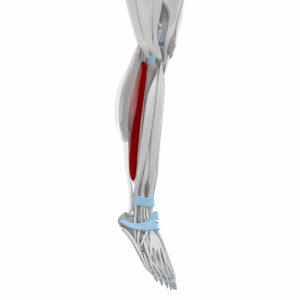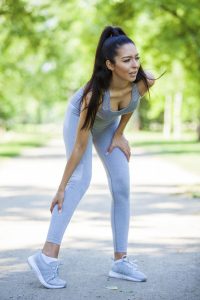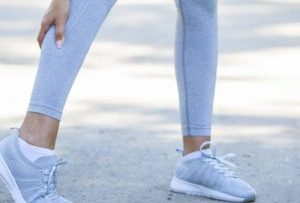The soleus is one of the three powerful muscles of the calf that lies behind the gastrocnemius, and runs from the Achilles tendon to behind, and just below, the knee. “The soleus is responsible for plantar flexion, which is when your toes point downward,” explains Tom Holland, an exercise physiologist, sports nutritionist, and coach. “That’s the push-off when you’re walking or running.” Do your personal training clients know the best ways to avoid soleus injuries?
Different Calf Muscles, Different Roles
The gastrocnemius, the large superficial muscle of the calf, is predominantly comprised of Type II fibers. These fibers power the explosive moves required in sprinting. In contrast, the soleus is a deeper muscle and is made up of more Type I endurance fibers. These are the fibers our bodies call upon when moving great distances, such as running a marathon. In addition, the gastroc is only powerful when the knee is straight. Since it attaches above the knee joint, at flexion, the muscle shortens and goes slack, known as active insufficiency.

Conversely, the soleus is most active when the knee is flexed since it no longer has the assistance of the gastroc. Think about running gait and foot strike: upon hitting the ground the knee must be slight bent, recruiting the soleus fibers to control dorsiflexion on the landing.
“The soleus is heavily relied upon for enduring mile after mile, which is why long-distance runners are usually the first ones to experience soreness and overuse pain in their soleus,” says David Siik, senior manager of running and creator of Precision Running at Equinox in Los Angeles. In working to stave off fatigue, the soleus can easily become stressed.
Soleus: The Shock Absorber
We have all had the experience of acute muscle soreness, especially if you’ve ever begun a running program. When the soleus muscle is tight or lacks strength, blood flow to the foot and ankle can be interrupted. This may render the entire calf to be “locked”, making it impossible to flex the foot. Clearly, this is not the scenario one wants to create as that marathon finish line looms in the distance!
“One of the big things that people forget about the calf is the fact that it’s absorbing shock,” Siik says. “Every time you step down at the end of your gait, your body has to brake. The muscles that are going to allow you to brake are your gastrocnemius and your soleus, in that order. It’s the last muscle to absorb the shock.”
If a trainer has had the opportunity to work with a client who is an avid runner, he may have observed how the client runs on the ball of his feet, or the forefoot. While this may, over time, lead to an overuse injury to the soleus, such a position works to protect the shock from shooting into the knees.

Woman gripping her calf after a soleus strain.
Strains and Pains
A soleus strain falls in the category of an overuse injury, which explains why endurance and long-distance runners present with this issue far more often than sprinters. While a strain to the gastrocnemius is more commonly seen, the soleus is considered to be at a much lower risk for injury. Soleus strains also tend to be less dramatic in clinical presentation, and much less acute when compared to injuries of the gastrocnemius.
The classic symptoms indicating a soleus strain are tightness in the entire calf muscle, stiffness, and pain that increases in intensity over several days or weeks. Swelling is typically mild; however, even the simple movements of walking and jogging will likely provoke and exacerbate the symptoms.
Functional Movement for the Soleus
With a clearer understanding of the mechanics of the lower leg, trainers can teach their clients how to take measures to prevent soleus strains and injuries.
- Warm up thoroughly. Performing light cardio (walking, jogging, or gentle cycling) before engaging in full-out running can significantly reduce the chance of injury.
- Pay attention to discomfort. Many runners like to get their minds “in the zone” with earbuds and a musical playlist. However, it is also important to be attuned to the body’s signals and stop running when experiencing pain or tightness in the calf region.
- Use a foam roller. A foam roller or other self-massage tool serves a key role in self-myofascial release, leading to an increase in range of motion as well as decreasing discomfort. Self-massage before and after long runs can help prime the muscle for running while increasing blood flow to prevent soreness. Data from a study conducted in 2018 revealed that foam rolling might also temporarily increase muscle length, which lends itself to greater flexibility. Statically stretching after the post-run roll-out will help maximize this effect and lengthen the muscle.
- Stretch. Experts in the field have differing opinions on the efficacy of stretching before running, since at that time the muscles are cold and more apt to be damaged. Foam rolling first can help bring blood into the muscle to prepare it for a static stretch. If the muscles of the calf are particularly short, then this approach can work. Performing dynamic stretches as part of a warm-up is generally a good idea; however, all professionals concur that stretching post-workout is beneficial.
Sample Stretches
Stretching enables the soleus muscle to reach its optimal length and tension, leading to more forceful contractions at the ankle joint.
A lunge stretch is fairly straightforward and can be performed anywhere, without special equipment.
- Facing a wall, stagger the feet by stepping back with the left foot and placing the left heel firmly on the floor toes pointed straight ahead.
- Step the right foot forward 6 inches from the wall, shifting bodyweight into it.
- Bend the right knee slightly and slowly until a stretch is felt in the back of the left upper calf (gastroc).
- After 30 seconds, bend the back knee as completely as possible.
- Here the tension switches from the gastrocnemius muscle to the Achilles tendon and soleus of the left leg.
- Repeat the stretch on the other leg.
Another simple and often-performed movement is the stair stretch.
- Position balls of both feet on the step of a staircase (Use the bottom step; in case of an accidental loss of balance, the client is pretty close to the floor! Holding the banister or wall with one hand is also highly recommended).
- Bend the right knee while simultaneously allowing the left heel to drop below the step.
- The gastrocnemius of the left leg should feel a significant stretch.
- After 30 seconds, bend the left knee to shift stretch to the soleus.
- After holding the stretch for 30 seconds, switch legs.
Once the stretches have been successfully completed, trainers can feel comfortable taking a client through his/her leg workout. To activate the deeper, slow-twitch soleus, trainers may wish to swap out regular calf raises with single-leg calf raises. For added weight, the client may choose to hold a dumbbell, plate or kettlebell in one hand. For an advanced lifter, single-leg deadlifts performed with dumbbells, or balancing on an unstable surface, will facilitate soleus strengthening.
Performing soleus stretches can have a positive impact on a client’s performance. However, if he/she has recently suffered an ankle sprain or other injury to the lower leg, remind him/her to consult with a physician before deeply stretching the soleus. The higher the angle of plantar flexion while performing the soleus stretch, the deeper and more intense the stretch will feel. Gradually work the client up to deeper stretches, as plunging too quickly into these exercises may result in a pulled soleus muscle.
References
en.wikipedia.org/wiki/Soleus_muscle
www.medicalnewstoday.com/articles/322809.php
www.sportsrec.com/398427-soleus-stretch.html
www.ncbi.nlm.nih.gov/pmc/articles/PMC2697334/
www.runnersworld.com/health-injuries/a22813018/soleus-muscle-pain/
Cathleen Kronemer is an NFPT CEC writer and a member of the NFPT Certification Council Board. Cathleen is an AFAA-Certified Group Exercise Instructor, NSCA-Certified Personal Trainer, ACE-Certified Health Coach, former competitive bodybuilder and freelance writer. She is employed at the Jewish Community Center in St. Louis, MO. Cathleen has been involved in the fitness industry for over three decades. Feel free to contact her at trainhard@kronemer.com. She welcomes your feedback and your comments!


